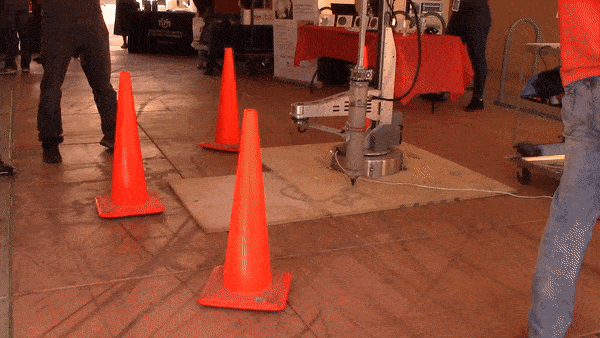Strategic Research Areas

3D printers for concrete and carbon fiber composites are being available in Dana Wood advanced materials laboratory. The UNM logo is printed here using cementitious composites at UNM School of Engineering Open House.
The Department of Civil, Construction and Environmental Engineering has an active and diverse research program with annual sponsored research expenditures of nearly $6 million. The department is involved with interdisciplinary research with the School of Medicine and the College of Arts & Sciences, and enjoys extensive interactions and collaborations with Los Alamos National Laboratory, Sandia National Laboratories, the Air Force Research Laboratory, the New Mexico Department of Transportation and the New Mexico Building Branch, and the Associated General Contractors.
Structures and Materials
The structural engineering group at UNM is focused upon the experimental and computational research for synthesis and characterization of resilient materials and structures. This includes, but is not limited to, structural health monitoring, nanomaterials for structural composites, aerospace materials and structures, self-healing materials, computational mechanics using advanced peridynamics and microstructural homogenization theories, and developing alternative cementing materials and experimental characterization of bamboo structures.

The Smart Management of Infrastructure Laboratory (SMILab) conducts research in innovative structural health monitoring techniques and in the development of hybrid sensors.
Peridynamic computational modeling of reinforced concrete structures is used to simulate cracking patterns for Brazilian split cyilinder problems and crack propagation pattern are observed.
Wth the support of New Mexico Department of Transportation, Glass Fiber Reinforced Polymers are fabricated and tested to retrofit Culverts in New Mexico. Pictures below show some examples of nanomaterials for structural composites: New polymer concrete with superior ductility using alumina nanoparticles have been invented. Also, Stowage and Deployment of a viscoelastic orthotropic carbon-fiber composite tape spring in the area of aerospace materials and structures is shown.
Intelligent and Sustainable Transportation
The Transportation Engineering Program takes a wide look at the technology, infrastructure, policy, and human behavior that affect the efficiency and sustainability of transportation systems. Our teaching, research, and outreach focus on two broad areas: Intelligent Transportation Systems, and Sustainable Transportation System Planning.
With Intelligent Transportation Systems our aim is finding more efficient ways to use our existing physical transportation infrastructure by applying advanced sensor and communications technology coupled with adaptive computer control systems to ease congestion, improve safety, and collect new travel information to support planning decisions and research.
The sustainable transportation system planning area focuses on developing new methods for evaluating the effectiveness and efficiency of regional transportation system plans and policies with the aim of discovering more environmentally and financially sustainable solutions. These aims are supported by collecting new travel behavior information, developing novel forecasting and prediction models, and evaluating decision making frameworks. Traffic engineering and regional travel demand modeling have been the primary areas of transportation engineering education and research. Our program offers a contemporary approach to these traditional focus areas.
Environment, Water, and Resource Development

Faculty in the department are consolidating and maximizing the water-and environmental-related research already under way across campus. Topics include a variety of challenges related to water, including the effects of wildfires and climate change on water availability; reservoir storage; advanced water and wastewater treatment to desalinate brackish ground water, recycle treated wastewater, and protect the environment; water for energy development and resource recovery; and water quality issues.
